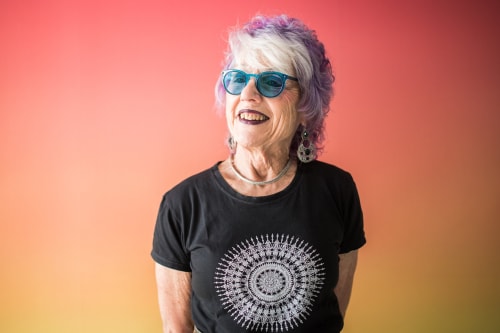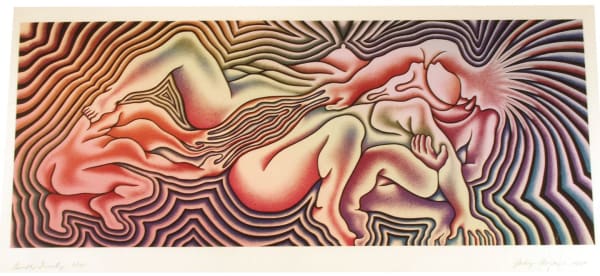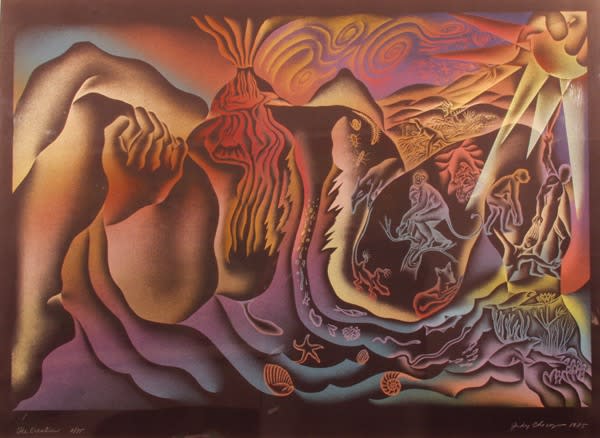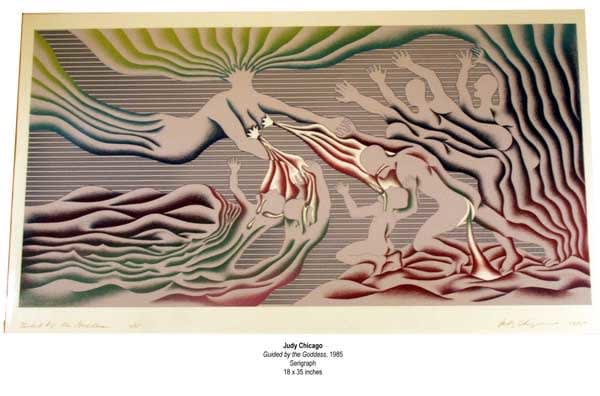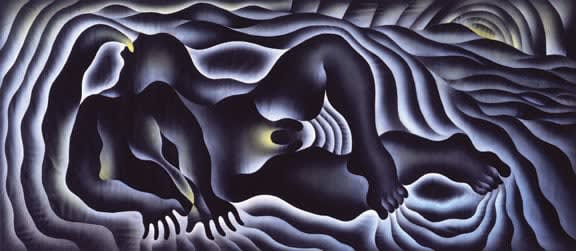Judy Chicago
Chicago's influence, both within and beyond the art community, is attested to by hundreds of publications throughout the world. Chicago's art has been frequently exhibited in the United States as well as in Canada, Europe, Asia, Australia, and New Zealand. A number of her books have been published in both English and foreign editions.
In the early 70s, after a decade of professional art practice, Chicago pioneered Feminist Art and art education through a unique program for women at California State University at Fresno. Chicago then brought this program to the California Institute of the Arts where she helped establish the Feminist Art Program: Womanhouse, the first installation demonstrating an openly female point of view in art. Chicago's ideas helped to initiate a worldwide Feminist Art Movement.
In 1974, Chicago directed her attention to the subject of women’s history and created her most well-known work: The Dinner Party. This work was executed between 1974 and 1979 with the participation of hundreds of volunteers. This monumental multimedia project, a symbolic history of women in western civilization, has been seen by more than one million viewers during its sixteen exhibitions held at venues spanning six countries.
The Dinner Party has been the subject of countless articles and art history texts and is included in publications from diverse fields. The importance of The Dinner Party, and her role as one of the founders of the Feminist Art Movement, was examined in the 1996 exhibition: Sexual Politics: Judy Chicago’s Dinner Party in Feminist Art History. The show was curated by Dr. Amelia Jones at the UCLA Armand Hammer Museum and was accompanied by an extensive catalog published by the University of California Press. In 2004 The Dinner Party was permanently housed at the Brooklyn Museum as the centerpiece of the Elizabeth A. Sackler Center for Feminist Art.
From 1980 to 1985, Chicago executed the Birth Project. Having observed an absence of iconography about the subject of birth in western art, Chicago designed a monumental series of birth and creation images for needlework. This project was executed by skilled needle workers under Chicago's supervision. The Birth Project employed the collaborative methods and a similar merging of concept and media that characterized The Dinner Party. Exhibited in more than 100 venues parts from the Birth Project can still be seen in numerous public collections around the country. The Albuquerque Museum retains the core collection of the Birth Project.
While producing the Birth Project Chicago also focused on creating Powerplay. In this unusual series of drawings, paintings, weavings, cast paper, and bronze reliefs Chicago brought a critical feminist gaze to the gender construct of masculinity, exploring how prevailing definitions of power have affected the world in general and men in particular.
The thought processes underlying Powerplay (Chicago's long concern with issues of power and powerlessness and her growing interest in her Jewish heritage) led her to her next body of art entitled The Holocaust Project: From Darkness Into Light. This work premiered in October 1993 at the Spertus Museum in Chicago then continued to travel to museums around the United States until 2002. The Holocaust Project: From Darkness Into Light evolved during eight years of inquiry, travel, study, and artistic creation. It includes a series of images merging her paintings with photography by Donald Woodman as well as with stained glass and tapestry designed by Chicago and executed by skilled artisans.
In 1996, the Arthur and Elizabeth Schlesinger Library on the History of Women in America at Radcliffe College, Cambridge, MA, became the repository for Chicago’s papers. Chicago is the first living artist to be included in this major archive.
For many decades, Chicago has produced works on paper, both monumental and intimate. These were the subject of an extensive retrospective which opened in 1999 at the Florida State University Art Museum in Tallahassee, Florida. Organized by Dr. Viki Thompson Wylder, a scholar on Chicago’s oeuvre, this retrospective was the first comprehensive examination of her art. The exhibit Trials and Tributes traveled through 2002 to eight venues and was accompanied by a catalog by Dr. Wylder along with an introduction by the renowned critic, Lucy Lippard.
In 1999, Chicago received from Indiana University a Presidential Appointment in Art and Gender Studies. In 2000, Chicago was awarded an Inter-Institutional-Artist-in-Residence at Duke University and at the University of North Carolina, Chapel Hill. In 2001, along with her husband, photographer Donald Woodman, Chicago undertook a project with students at Western Kentucky University commemorating the thirty-year anniversary of Womanhouse. Working with students, faculty and local artists, Chicago and Woodman developed a project titled At Home. It re-examined the subject of the house from the perspective of residents of Kentucky. In 2003, Chicago and Woodman facilitated an ambitious inter-institutional project entitled Envisioning the Future in Pomona, California.
In 1994 Chicago began another collaborative project, Resolutions: A Stitch in Time, with skilled needle workers. Resolutions: A Stitch in Time combines painting and needlework in a series of exquisitely crafted and inspiring images that reinterpret traditional adages and proverbs. The exhibition opened in June 2000 at the American Craft Museum in New York City and was toured to seven venues around the United States and Canada.
In October 2002 a major exhibition surveying Chicago's career was presented at the National Museum of Women in the Arts. The show was accompanied by a catalog edited by Dr. Elizabeth A. Sackler, with essays by Lucy Lippard and Dr. Viki Thompson Wylder and an Introduction by Edward Lucie-Smith.
In 2004, Chicago published Fragments From the Delta Of Venus (powerHouse Books), a collection of images based upon the erotic writing of Anais Nin. Also included in this book is an essay about Chicago's relationship with Nin who was her mentor in the early seventies. In conjunction with the book's publication a number of exhibits were held around the country surveying Chicago's erotic work, created over three decades. For many years, Judy Chicago has been interested in redressing the iconographic void around women's perspective on sexuality and desire.
At present Chicago is working in glass, pushing the boundaries of the medium in ways that have not been previously explored. Her first work, Rainbow Shabbat, a 16 foot triptych in stained glass, served as the final image for the Holocaust Project. Chicago collaborated with the Dobbins Studio of Santa Fe on a series that involves repeated painting, carving and firing of fused and cast glass. In 2007 the exhibition Chicago in Glass opened at the Canadian Clay and Glass Gallery in Waterloo, Ontario.
In addition to a life of prodigious art making, Judy Chicago is the author of seven books: Through the Flower: My Struggle as a Woman Artist, 1975 (subsequently published in England, Germany, Japan, and Taiwan); The Dinner Party: A Symbol of Our Heritage, 1979; Embroidering Our Heritage: The Dinner Party Needlework, 1980 (subsequently published in a combined edition in Germany); The Birth Project, 1985 (Anchor/Doubleday); Holocaust Project: From Darkness into Light, 1993; The Dinner Party/Judy Chicago, 1996; Beyond the Flower: The Autobiography of a Feminist Artist, 1996 (Viking Penguin).
In 1999, Chicago co-authored with Edward Lucie-Smith, the well-known British art writer, Women and Art: Contested Territory. This book was published in the U.S., Canada, England, Australia, New Zealand, and Germany. It examines images of women by both male and female artists throughout history.
Chicago was the subject of a richly illustrated monograph, An American Vision, by Edward Lucie-Smith. This book, published in 2000, provided the first comprehensive assessment of her body of art.
Many films have been produced about her work including Right Out of History; The Making of Judy Chicago’s Dinner Party by Johanna Demetrakas; documentaries on Womanhouse, the Birth Project, the Holocaust Project and Resolutions; and two films produced by the Canadian Broadcast Corporation, Under Wraps and The Other Side of the Picture. E Entertainment Television included her in its three part program, World’s Most Intriguing Women.
Photo Credit: Donald Woodman
